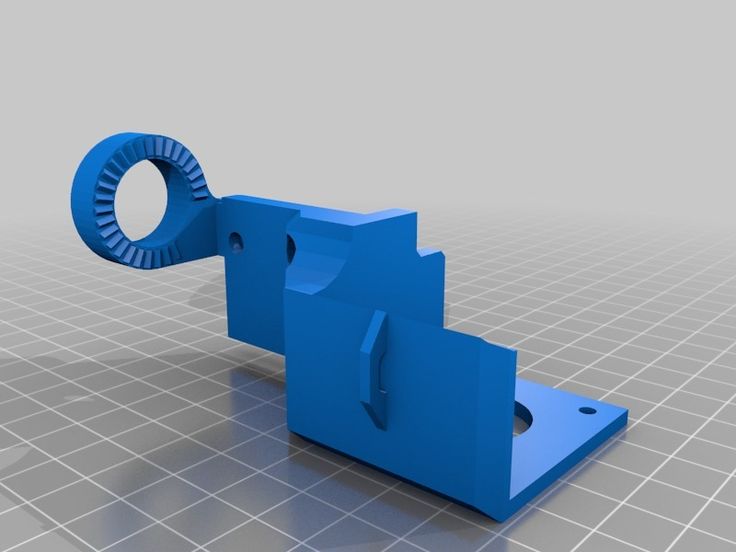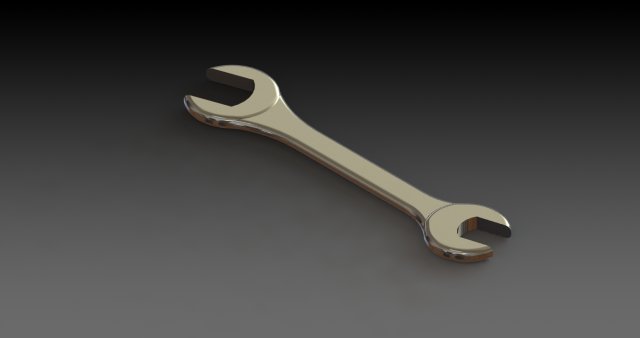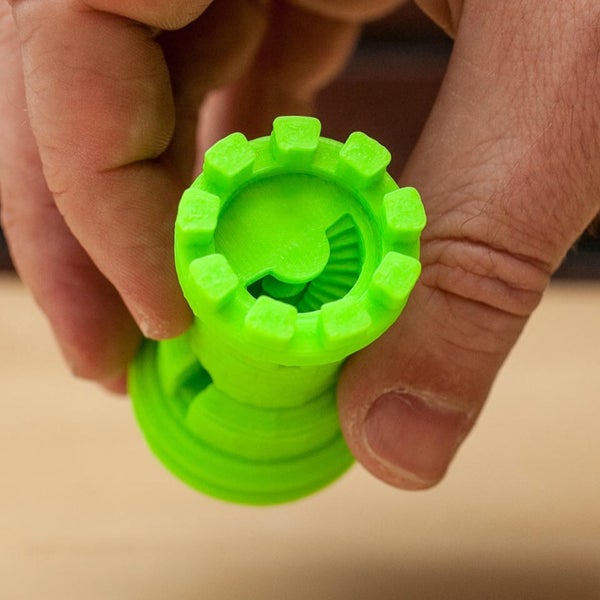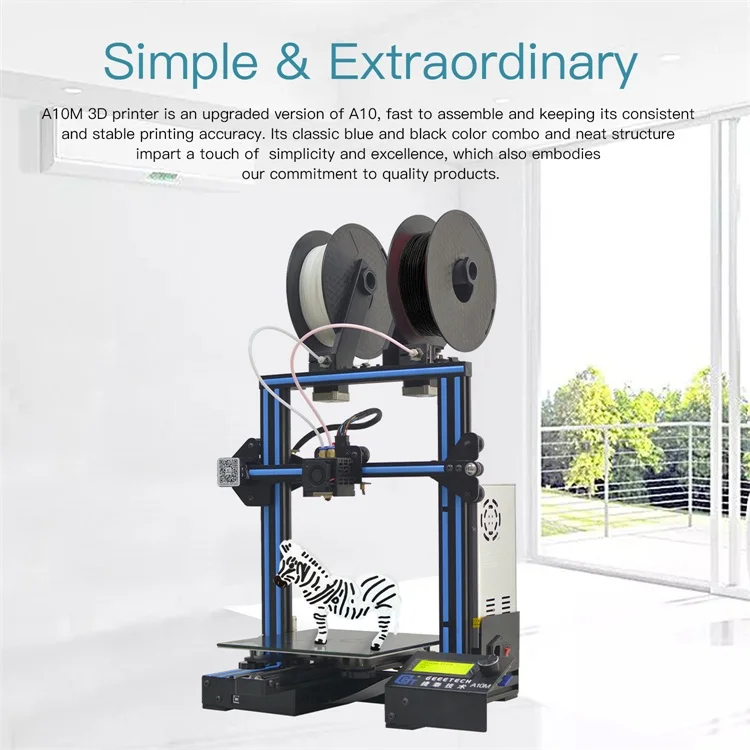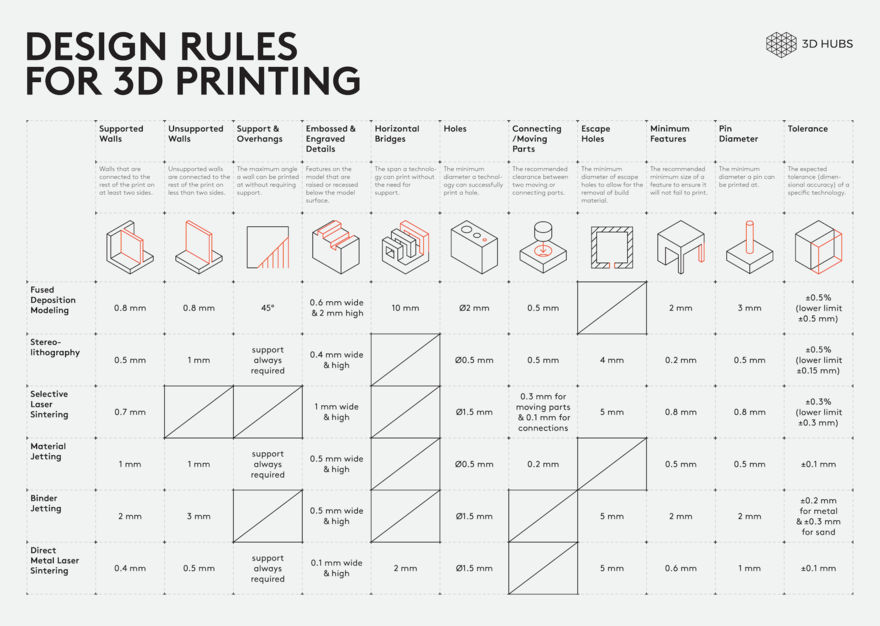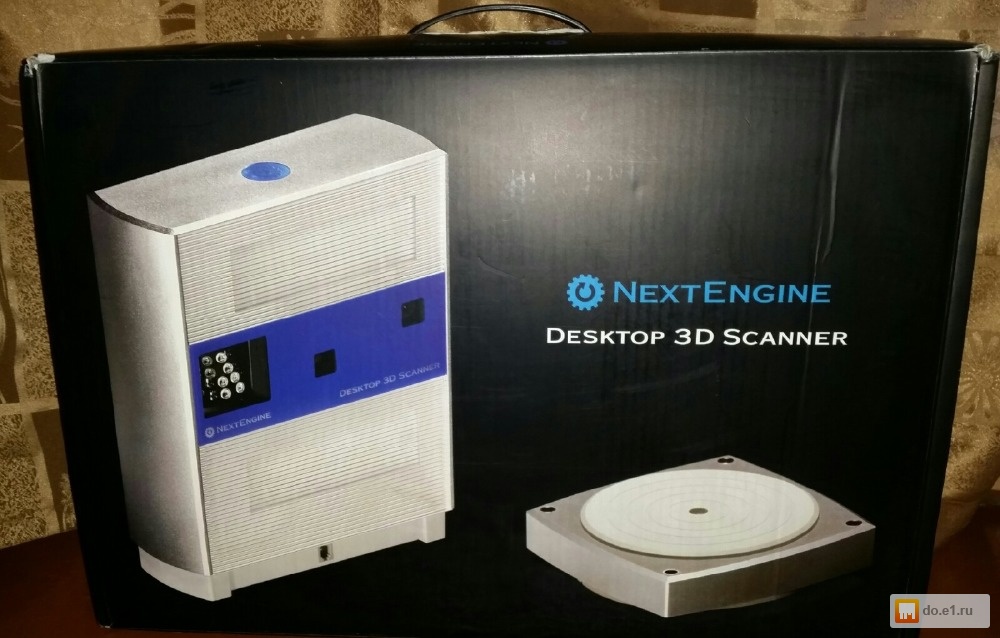3D print custom miniatures
Guide to Accurate 3D printed Custom Miniatures
Miniatures are small scale replicas or models of something else. Sometimes these are toys, props, demonstrational pieces, or collectibles. Due to their tiny size and precise details, minis may be complicated to handcraft, especially in a larger quantity. 3D printing, on the other hand, provides a way to manufacture miniatures with decent quality and production time. But in order to make it work for your needs, there are a few facts to consider in regards to 3D printing small figurines and minis.
- 3D Printing Technologies comparison
- Materials Rundown
- Post-Processing for printed Minis
- Quick design tips for each Printing tech
- Why should I choose to 3D print miniatures?
- How to order 3D printing of miniatures
Different types of miniatures
There are several areas, where small scale replicas and models are used, each sphere with its intricacies respectively. Here is a quick rundown of the small size figurines we are touching upon:
- Tabletop wargaming minis
- Action figures
- Model figures
- Scale models
- Diorama pieces
- Landscape models
- Rail transport models
- Dollhouse props
- Educational models
Though all miniatures have much in common, they differ not only in size but also in the functionality of pieces as well as accuracy and stiffness requirements. As a result, certain production methods and 3D printing materials will suit each type of piece better.
Miniatures and figurines can potentially be 3D printed using any available method. However, depending on the application and requirements, some techs are more suitable than others.
| Technology | Material type | Affordable | Detail Quality | Stiffness | Color |
| FDM/FFF | Plastic | 5/5 | 2/5 | 4/5 | Usually monochrome |
| [Resin] SLA | Resin | 3/5 | 5/5 | 3.5/5 | Monochrome |
| [Resin] DLP | Resin | 3/5 | 4.5/5 | 3.5/5 | Monochrome |
| [Resin] DUP | Resin | 4/5 | 4/5 | 3.5/5 | Monochrome |
| [Resin] MJ/Polyjet | Resin | 2/5 | 5/5 | 4/5 | Full-Color |
| SLS | Nylon Powder | 3/5 | 4/5 | 4/5 | Monochrome |
| CJP | Sandstone | 2/5 | 3/5 | 2/5 | Full-Color |
3D Print your Miniature
FDM/FFF
One of the most affordable methods works by heating up plastic strings and using it to form a piece layer by layer.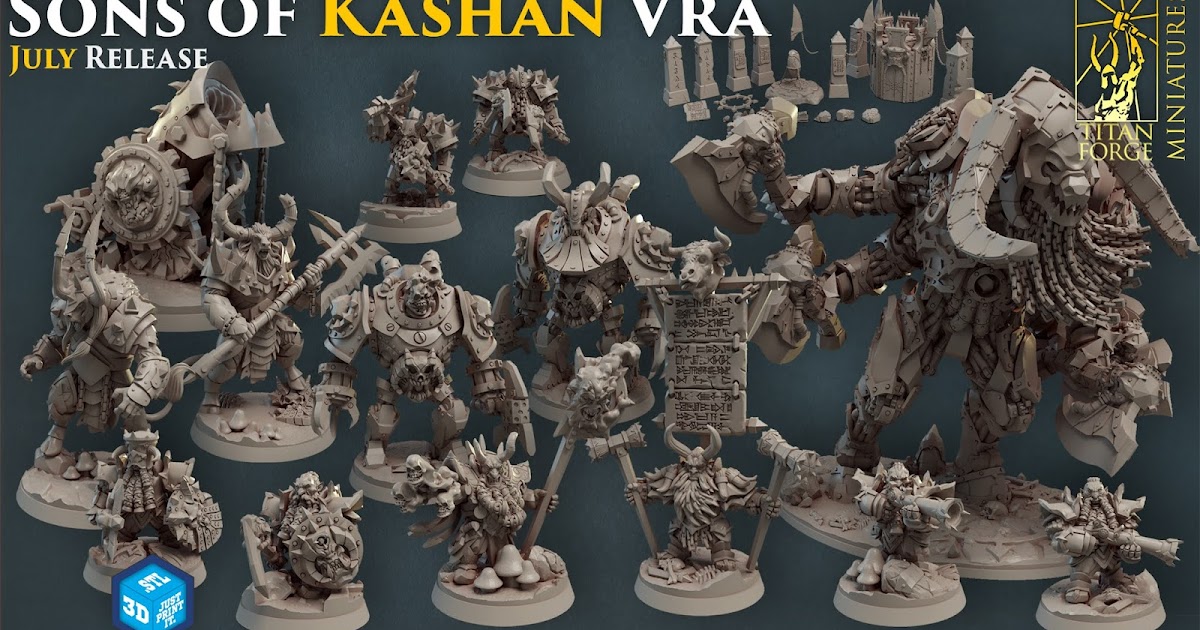 The big downside of the technology is that it leaves some layer lines as well as marks under overhanging parts. In order to print minis with FDM, it is usually required to have a separate, thinner nozzle, and slower printing time to ensure better details. Fused deposition modeling, though, can work fine for bigger scale models, some educational models, and rail transport models of larger size.
The big downside of the technology is that it leaves some layer lines as well as marks under overhanging parts. In order to print minis with FDM, it is usually required to have a separate, thinner nozzle, and slower printing time to ensure better details. Fused deposition modeling, though, can work fine for bigger scale models, some educational models, and rail transport models of larger size.
Figurine 3D printed on FDM machine by OKSharPei 3D
VAT polymerization/Resin printing
Resin 3D printing is a family of technologies that cures liquid photopolymers layer by layer by laser, LEDs, or projectors. These methods suit miniatures really well as they allow preserving intricate details while keeping a smooth surface. However, you should take into consideration that some resins or technologies suit it better. For example, laser-based machines commonly help avoid voxelization of a piece. And for high-detailed minis, special HD resins are recommended. Overall, SLA miniatures are suggested for tabletop wargaming that doesn't require functioning parts.
Overall, SLA miniatures are suggested for tabletop wargaming that doesn't require functioning parts.
3D print by Brandon's 3D Printing
MJ/Polyjet
This set of 3D printing technologies works with UV-activated resins. But contrary to vat polymerization methods, it works with droplets of resins, which allows mixing them to get different colors and properties. These advantages make MJ a good method for educational and demonstration models.
3D print by AllgaeuTec
Laser Sintering
Powder sintering is usually a professional manufacturing method that relies on sintering nylon-based powders. It is capable of making sturdy and accurate minis free of layer lines. Aside from costly production, laser sintering has some limits to its precision, but overall allows a great quality of figurines. If preceding through sintering, it is a good idea to order a small batch rather than a single piece to save some money as nesting (printing a batch) is usually more cost-efficient. This method should suit action figurines, props, and landscape models.
This method should suit action figurines, props, and landscape models.
3D printed chess set from a personal portfolio of Rapid 3D Parts
Color Jet Printing
CJP technology uses sandstone powder and a binding agent that fuses grains together layer by layer. In the process, inks add color to a part. Through combining several primary colors, these machines commonly deliver a wide range of shades. End results are full-colored, they have a medium quality of details. Compared to other methods, CJP provides more brittle minis. Consider choosing Color Jet Printing for colored landscape models, model figurines that won't be actively used or memorabilia pieces.
3D print by Make it 3D Manufacturing Center
Within each 3D printing technology, there are always several material options. Choosing a suitable one for your mini makes or breaks the results.
FDM Plastic
PLA is one of the most common and user-friendly plastics out there.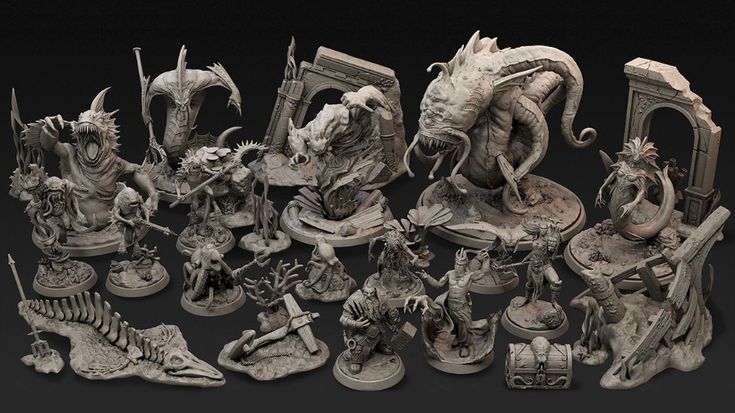 There are many interesting options available as well as colors. It is one of the best filaments in terms of details, and medium choice in regards to stiffness and temperature resistance. With right post-processing and coating, PLA will be serving you decently.
There are many interesting options available as well as colors. It is one of the best filaments in terms of details, and medium choice in regards to stiffness and temperature resistance. With right post-processing and coating, PLA will be serving you decently.
Other FDM options include ABS, PETG, Wood-filled plastics, and many more. However, these are usually the types of plastic printed with higher temperatures, which raises chances of failures and artifacts such as echoing and warping.
Generic resin
All-purpose resin is a standard photopolymer used. It is easy to find, and it produces fine results in terms of detailing. It is a bit brittle in thinner areas and prone to warping in unsupported small overhangs.
High-detail resins
With a bit different formulation, these resins allow getting more details to come out. Even when a machine’s resolution allows it to go to 25-50 microns precision, other resins may not support that tolerance. HD resins, on the other hand, are designed to allow 3D printing such fine elements.
SLS Nylon
PA 12 is a pretty standard material used in Laser sintering. It combines good detail transition and technical parameters. Other grades of nylon are okay to use for minis, too. Such materials are pa 6, pa 6/69, and more. For miniature printing, composites or flexibles would be a bad choice, so sticking to usual polyamide is the best you can do.
Sandstone
Sandstone is one of the primary materials used in CJP along with powders like gypsum or nylons.
Polyjet polymers
MJ processes use UV-activated polymers close to the resins in SLA and DLP printers. However, these machines are able to combine and blend together different grades of their own polymers to get complex results. Some common materials include Rigid opaque resins and Clear ones, Vero, Agilus, Tango, and more. They can either provide a glossy-looking smooth surface finish or matte texture.
All 3D printed miniatures require post-processing and finishing touches, though some may need less work than others.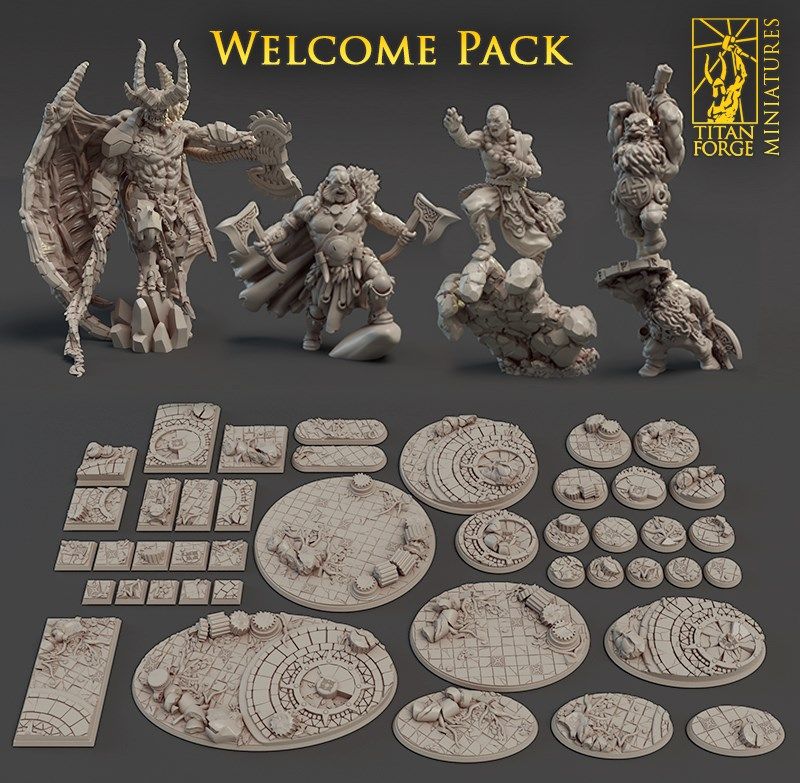 Key steps for all printed figurines are likely to include:
Key steps for all printed figurines are likely to include:
- Supports removal
- Sanding
- Smoothing or Polishing
- Sealing
For 3D printing processes except for powder-based ones (SLS, CJP), a miniature will probably require cleaning the surface from supporting structures. This process is usually easy but requires accuracy and patience when it comes to small pieces. The main goal is to ensure intricate details will not be damaged. Many 3D printing services offer support removal but can charge an additional fee for smaller models or large quantities since it is a time-consuming task.
Supporting structures can be removed at home as well without much special skills or tools required.
Check out custom tabletop miniatures:
Another step to getting a good-looking miniature is to ensure you have a proper 3D design. Certain metrics and clearance must be included in a model with technology in mind. Thus, it is a good idea to settle on a printing method before making or optimizing a file. Here are some general tolerance guidelines for the mentioned technologies.
Here are some general tolerance guidelines for the mentioned technologies.
FDM
- Try to reduce the number of overhangs and angles less than 45 degrees;
- Model design details to be larger than 1.15 mm or at least 0.5 mm;
- Ensure a model's wall thickness of 1.2 mm at least;
- For text, prefer thicker fonts and opt for 1 mm depth/height for it.
Resin Printing
- Model figurines hollow if you want to reduce cost;
- Include escape holes to the design to avoid uncured resin inside your piece;
- If possible, keep the detail size greater than 0.05mm.
SLS and CJP
- Hollow enclosed parts are not possible, thus, include holes or model parts solid;
- Recommended detail size is bigger than 0.8 mm;
- Suggested wall thickness is around 0.7 mm - 2.0 mm;
- For text details, ensure depth/height about 2 mm.
For beginners, it can be a good idea to use someone's designs that were tested for 3D printing before. Or, as an option, you can hire a designer to either create a custom model or rework the one you have on hand to suit the process.
Or, as an option, you can hire a designer to either create a custom model or rework the one you have on hand to suit the process.
3D printing is a good method of getting custom parts in low quantities. With a ready 3D model, turnaround times for printing figurines are also quite short. FDM and DUP printing methods are usually affordable as well. More precise methods have a competitive advantage of accuracy when it comes to thin details and allow to create smaller figurines.
3D printed D&D miniatures will not be able to fully replace outstanding handmade pieces, however, it they are a fine alternative or a base for painting and customizing.
Additionally, when several similar models are required, a 3D printed master model will come in handy for casting purposes.
3D print by 3D Printer Filaments
There are 2 main options you can use to order 3D printing of miniatures through Treatstock:
- Instant Order
- Getting a Quote
If you already have a printable 3D miniature and know for sure what material suits your application, then instant order will probably be the easiest way for you.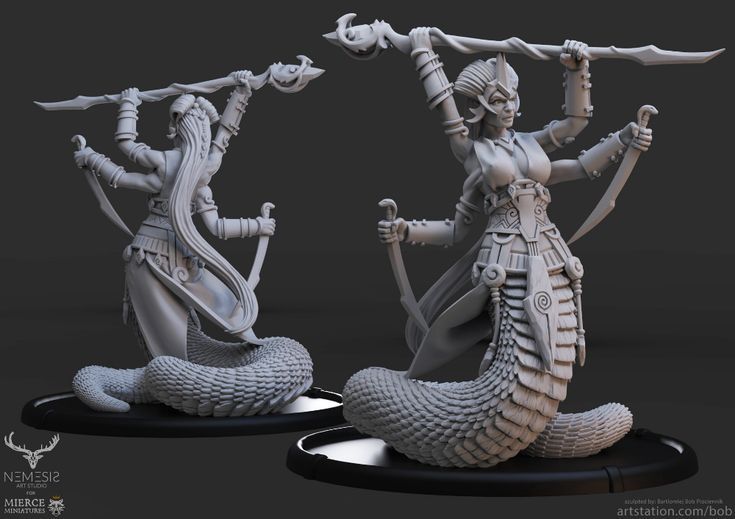 Upload your model, choose specifications, and fill in delivery details to get the cost estimation and order 3D prints:
Upload your model, choose specifications, and fill in delivery details to get the cost estimation and order 3D prints:
For more complicated models or projects without optimized 3D models, we recommend using the “Get a Quote” option. A quote allows contacting a print service before setting up on a price and specifications. That way you can get help with choosing proper settings and technology to achieve the goals or order additional services like post-processing, painting, and coating.
To search for vendors that offer 3D printing, visit the catalog for miniature printers here. This way also helps to find a specific technology like SLA printing service or Material Jetting.
You can also check out design on-demand offers to have a starting point and apply for a 3D model first or find a suitable 3D printed tabletop pieces in our store.
Guides Introduction to 3D Printing custom miniatures
Miniatures are small scale replicas or models of something else. Sometimes these are toys, props, demonstrational pieces, or collectibles.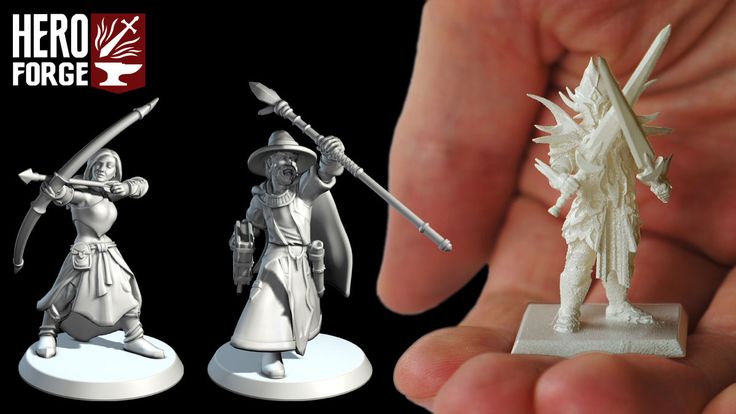 Due to their tiny size and precise details, minis may be complicated to handcraft, especially in a larger quantity. 3D printing, on the other hand, provides a way to manufacture miniatures with decent quality and production time. But in order to make it work for your needs, there are a few facts to consider in regards to 3D printing small figurines and minis.
Due to their tiny size and precise details, minis may be complicated to handcraft, especially in a larger quantity. 3D printing, on the other hand, provides a way to manufacture miniatures with decent quality and production time. But in order to make it work for your needs, there are a few facts to consider in regards to 3D printing small figurines and minis.
- 3D Printing Technologies comparison
- Materials Rundown
- Post-Processing for printed Minis
- Quick design tips for each Printing tech
- Why should I choose to 3D print miniatures?
- How to order 3D printing of miniatures
Different types of miniatures
There are several areas, where small scale replicas and models are used, each sphere with its intricacies respectively. Here is a quick rundown of the small size figurines we are touching upon:
- Tabletop wargaming minis
- Action figures
- Model figures
- Scale models
- Diorama pieces
- Landscape models
- Rail transport models
- Dollhouse props
- Educational models
Though all miniatures have much in common, they differ not only in size but also in the functionality of pieces as well as accuracy and stiffness requirements.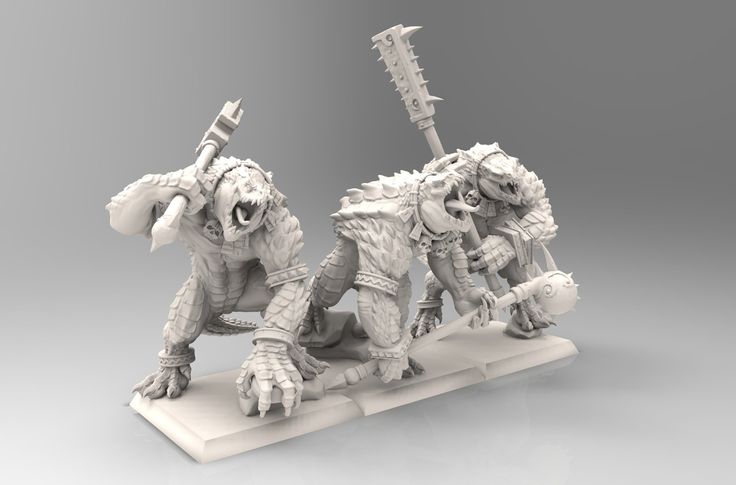 As a result, certain production methods and 3D printing materials will suit each type of piece better.
As a result, certain production methods and 3D printing materials will suit each type of piece better.
Miniatures and figurines can potentially be 3D printed using any available method. However, depending on the application and requirements, some techs are more suitable than others.
| Technology | Material type | Affordable | Detail Quality | Stiffness | Color |
| FDM/FFF | Plastic | 5/5 | 2/5 | 4/5 | Usually monochrome |
| [Resin] SLA | Resin | 3/5 | 5/5 | 3.5/5 | Monochrome |
| [Resin] DLP | Resin | 3/5 | 4.5/5 | 3.5/5 | Monochrome |
| [Resin] DUP | Resin | 4/5 | 4/5 | 3.5/5 | Monochrome |
| [Resin] MJ/Polyjet | Resin | 2/5 | 5/5 | 4/5 | Full-Color |
| SLS | Nylon Powder | 3/5 | 4/5 | 4/5 | Monochrome |
| CJP | Sandstone | 2/5 | 3/5 | 2/5 | Full-Color |
3D Print your Miniature
FDM/FFF
One of the most affordable methods works by heating up plastic strings and using it to form a piece layer by layer. The big downside of the technology is that it leaves some layer lines as well as marks under overhanging parts. In order to print minis with FDM, it is usually required to have a separate, thinner nozzle, and slower printing time to ensure better details. Fused deposition modeling, though, can work fine for bigger scale models, some educational models, and rail transport models of larger size.
The big downside of the technology is that it leaves some layer lines as well as marks under overhanging parts. In order to print minis with FDM, it is usually required to have a separate, thinner nozzle, and slower printing time to ensure better details. Fused deposition modeling, though, can work fine for bigger scale models, some educational models, and rail transport models of larger size.
Figurine 3D printed on FDM machine by OKSharPei 3D
VAT polymerization/Resin printing
Resin 3D printing is a family of technologies that cures liquid photopolymers layer by layer by laser, LEDs, or projectors. These methods suit miniatures really well as they allow preserving intricate details while keeping a smooth surface. However, you should take into consideration that some resins or technologies suit it better. For example, laser-based machines commonly help avoid voxelization of a piece. And for high-detailed minis, special HD resins are recommended. Overall, SLA miniatures are suggested for tabletop wargaming that doesn't require functioning parts.
Overall, SLA miniatures are suggested for tabletop wargaming that doesn't require functioning parts.
3D print by Brandon's 3D Printing
MJ/Polyjet
This set of 3D printing technologies works with UV-activated resins. But contrary to vat polymerization methods, it works with droplets of resins, which allows mixing them to get different colors and properties. These advantages make MJ a good method for educational and demonstration models.
3D print by AllgaeuTec
Laser Sintering
Powder sintering is usually a professional manufacturing method that relies on sintering nylon-based powders. It is capable of making sturdy and accurate minis free of layer lines. Aside from costly production, laser sintering has some limits to its precision, but overall allows a great quality of figurines. If preceding through sintering, it is a good idea to order a small batch rather than a single piece to save some money as nesting (printing a batch) is usually more cost-efficient.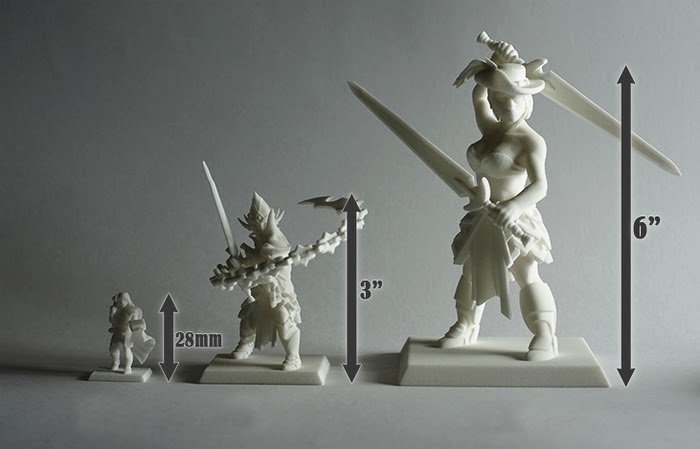 This method should suit action figurines, props, and landscape models.
This method should suit action figurines, props, and landscape models.
3D printed chess set from a personal portfolio of Rapid 3D Parts
Color Jet Printing
CJP technology uses sandstone powder and a binding agent that fuses grains together layer by layer. In the process, inks add color to a part. Through combining several primary colors, these machines commonly deliver a wide range of shades. End results are full-colored, they have a medium quality of details. Compared to other methods, CJP provides more brittle minis. Consider choosing Color Jet Printing for colored landscape models, model figurines that won't be actively used or memorabilia pieces.
3D print by Make it 3D Manufacturing Center
Within each 3D printing technology, there are always several material options. Choosing a suitable one for your mini makes or breaks the results.
FDM Plastic
PLA is one of the most common and user-friendly plastics out there.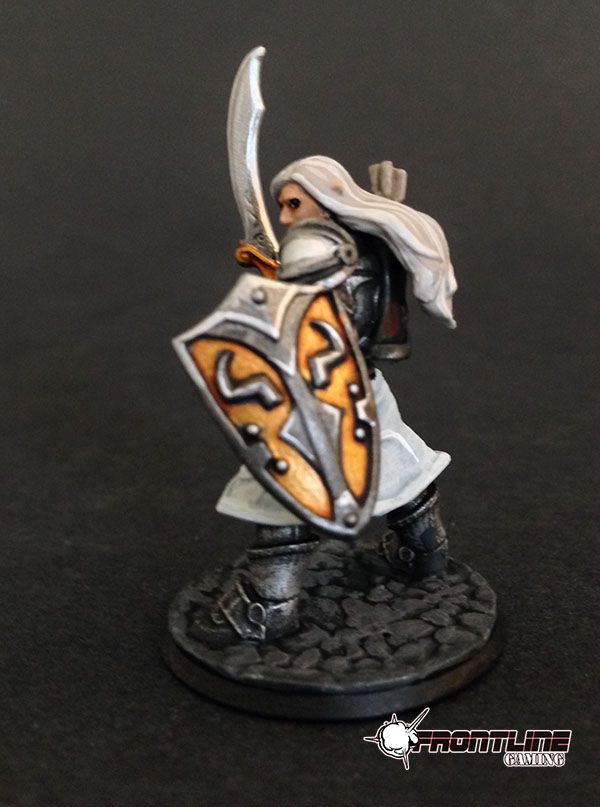 There are many interesting options available as well as colors. It is one of the best filaments in terms of details, and medium choice in regards to stiffness and temperature resistance. With right post-processing and coating, PLA will be serving you decently.
There are many interesting options available as well as colors. It is one of the best filaments in terms of details, and medium choice in regards to stiffness and temperature resistance. With right post-processing and coating, PLA will be serving you decently.
Other FDM options include ABS, PETG, Wood-filled plastics, and many more. However, these are usually the types of plastic printed with higher temperatures, which raises chances of failures and artifacts such as echoing and warping.
Generic resin
All-purpose resin is a standard photopolymer used. It is easy to find, and it produces fine results in terms of detailing. It is a bit brittle in thinner areas and prone to warping in unsupported small overhangs.
High-detail resins
With a bit different formulation, these resins allow getting more details to come out. Even when a machine’s resolution allows it to go to 25-50 microns precision, other resins may not support that tolerance. HD resins, on the other hand, are designed to allow 3D printing such fine elements.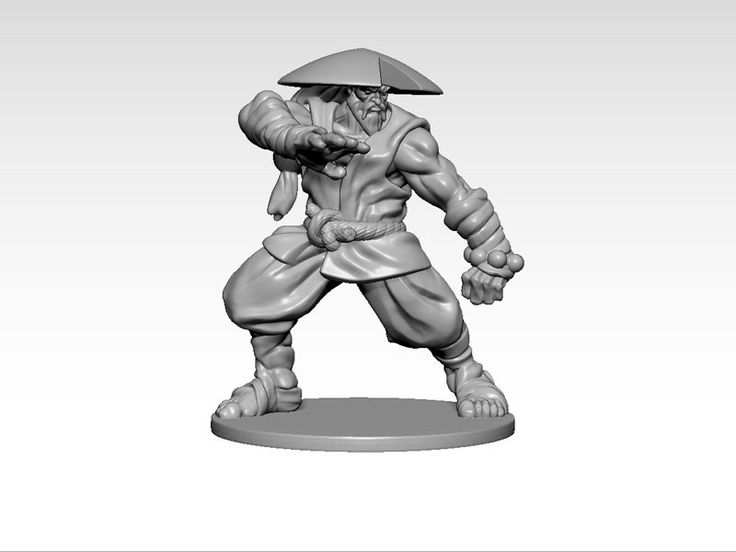
SLS Nylon
PA 12 is a pretty standard material used in Laser sintering. It combines good detail transition and technical parameters. Other grades of nylon are okay to use for minis, too. Such materials are pa 6, pa 6/69, and more. For miniature printing, composites or flexibles would be a bad choice, so sticking to usual polyamide is the best you can do.
Sandstone
Sandstone is one of the primary materials used in CJP along with powders like gypsum or nylons.
Polyjet polymers
MJ processes use UV-activated polymers close to the resins in SLA and DLP printers. However, these machines are able to combine and blend together different grades of their own polymers to get complex results. Some common materials include Rigid opaque resins and Clear ones, Vero, Agilus, Tango, and more. They can either provide a glossy-looking smooth surface finish or matte texture.
All 3D printed miniatures require post-processing and finishing touches, though some may need less work than others.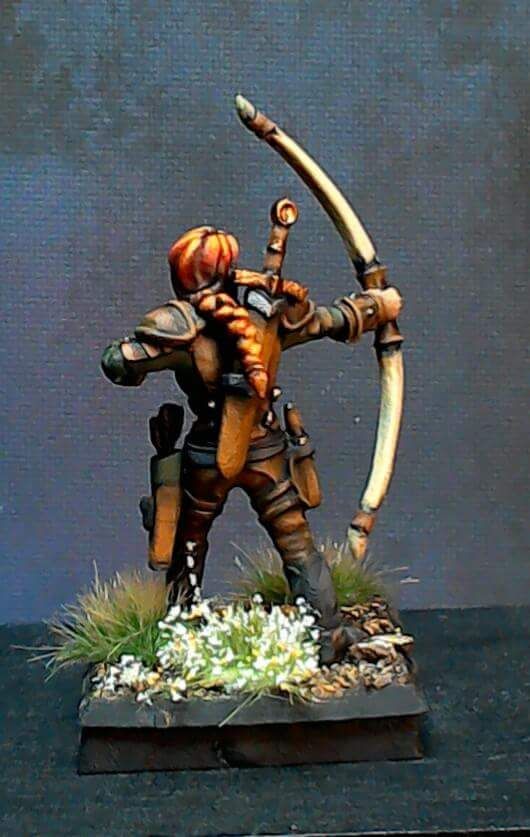 Key steps for all printed figurines are likely to include:
Key steps for all printed figurines are likely to include:
- Supports removal
- Sanding
- Smoothing or Polishing
- Sealing
For 3D printing processes except for powder-based ones (SLS, CJP), a miniature will probably require cleaning the surface from supporting structures. This process is usually easy but requires accuracy and patience when it comes to small pieces. The main goal is to ensure intricate details will not be damaged. Many 3D printing services offer support removal but can charge an additional fee for smaller models or large quantities since it is a time-consuming task.
Supporting structures can be removed at home as well without much special skills or tools required.
Check out custom tabletop miniatures:
Another step to getting a good-looking miniature is to ensure you have a proper 3D design. Certain metrics and clearance must be included in a model with technology in mind. Thus, it is a good idea to settle on a printing method before making or optimizing a file.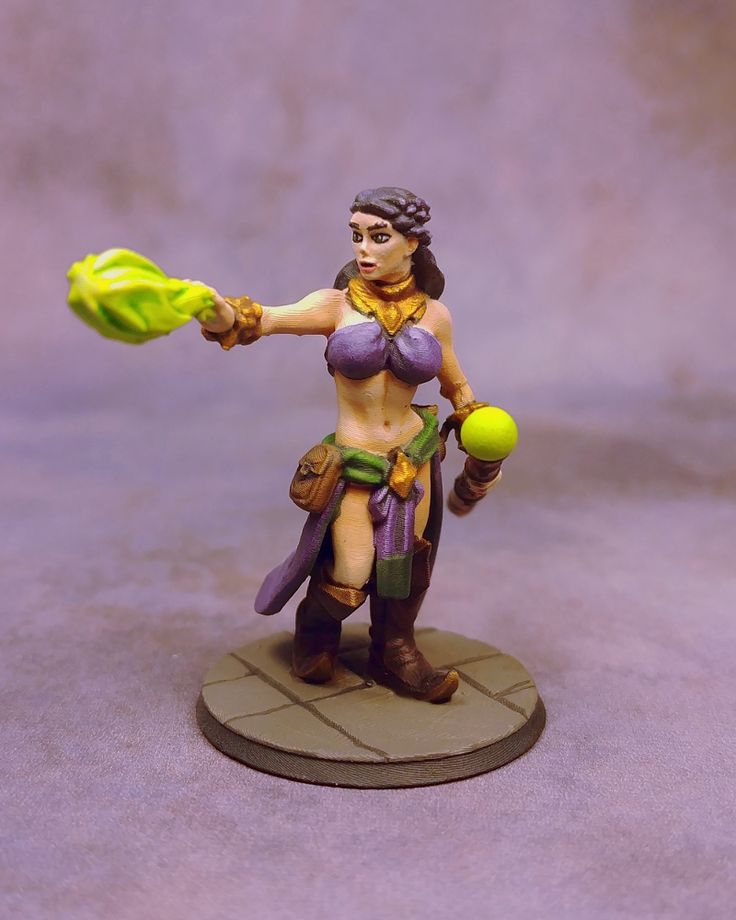 Here are some general tolerance guidelines for the mentioned technologies.
Here are some general tolerance guidelines for the mentioned technologies.
FDM
- Try to reduce the number of overhangs and angles less than 45 degrees;
- Model design details to be larger than 1.15 mm or at least 0.5 mm;
- Ensure a model's wall thickness of 1.2 mm at least;
- For text, prefer thicker fonts and opt for 1 mm depth/height for it.
Resin Printing
- Model figurines hollow if you want to reduce cost;
- Include escape holes to the design to avoid uncured resin inside your piece;
- If possible, keep the detail size greater than 0.05mm.
SLS and CJP
- Hollow enclosed parts are not possible, thus, include holes or model parts solid;
- Recommended detail size is bigger than 0.8 mm;
- Suggested wall thickness is around 0.7 mm - 2.0 mm;
- For text details, ensure depth/height about 2 mm.
For beginners, it can be a good idea to use someone's designs that were tested for 3D printing before.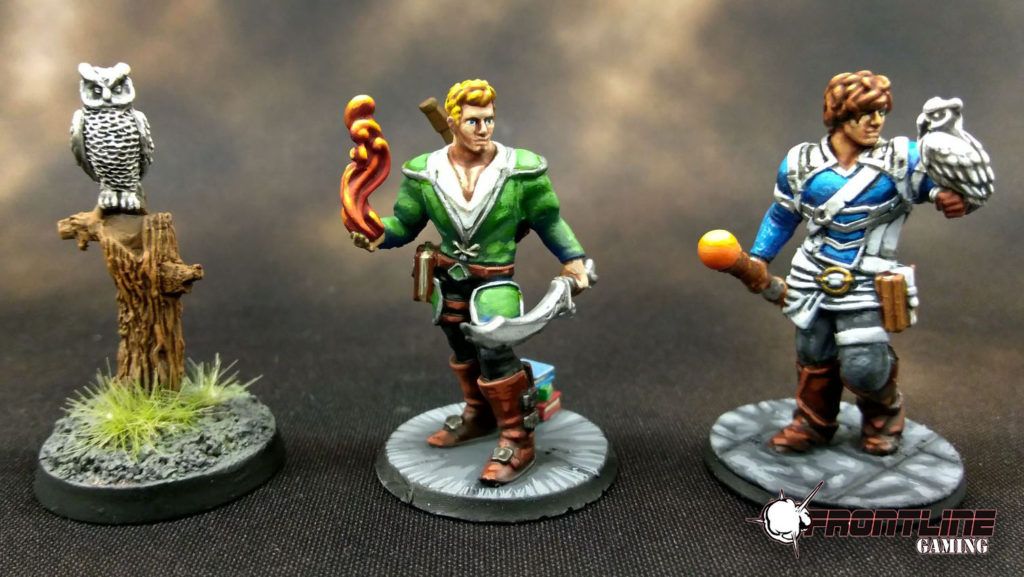 Or, as an option, you can hire a designer to either create a custom model or rework the one you have on hand to suit the process.
Or, as an option, you can hire a designer to either create a custom model or rework the one you have on hand to suit the process.
3D printing is a good method of getting custom parts in low quantities. With a ready 3D model, turnaround times for printing figurines are also quite short. FDM and DUP printing methods are usually affordable as well. More precise methods have a competitive advantage of accuracy when it comes to thin details and allow to create smaller figurines.
3D printed D&D miniatures will not be able to fully replace outstanding handmade pieces, however, it they are a fine alternative or a base for painting and customizing.
Additionally, when several similar models are required, a 3D printed master model will come in handy for casting purposes.
3D print by 3D Printer Filaments
There are 2 main options you can use to order 3D printing of miniatures through Treatstock:
- Instant Order
- Getting a Quote
If you already have a printable 3D miniature and know for sure what material suits your application, then instant order will probably be the easiest way for you.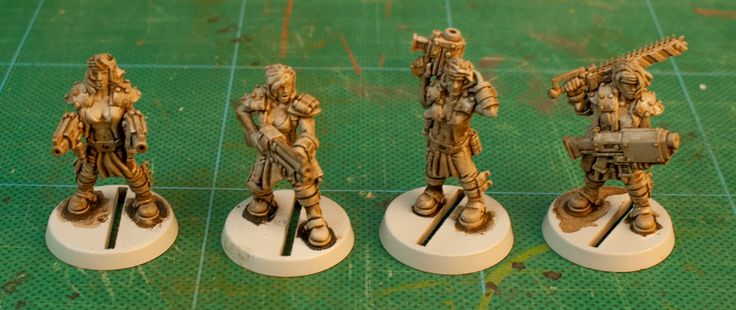 Upload your model, choose specifications, and fill in delivery details to get the cost estimation and order 3D prints:
Upload your model, choose specifications, and fill in delivery details to get the cost estimation and order 3D prints:
For more complicated models or projects without optimized 3D models, we recommend using the “Get a Quote” option. A quote allows contacting a print service before setting up on a price and specifications. That way you can get help with choosing proper settings and technology to achieve the goals or order additional services like post-processing, painting, and coating.
To search for vendors that offer 3D printing, visit the catalog for miniature printers here. This way also helps to find a specific technology like SLA printing service or Material Jetting.
You can also check out design on-demand offers to have a starting point and apply for a 3D model first or find a suitable 3D printed tabletop pieces in our store.
90,000 manufacturing miniatures 28mm, dioram, game locations using 3D printer09.03.2022
Content
- How to choose a 3D printer for miniatures
- Advantage of 3D printing for miniatures 9000 9000 FDM 9000 LCD/ DLP
- FDM
- LCD
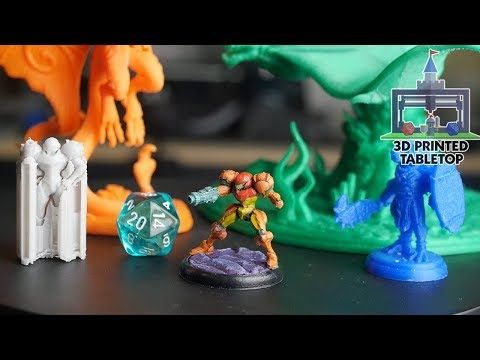
Miniature figurines with amazing detail attract the eye. A little grotesqueness and slightly wrong proportions (otherwise it would be inconvenient to play or transport such a “little one”) are more than compensated by detailed elaboration and an abundance of small, at first glance, insignificant details. These are no longer just small table soldiers, but heroes with their own unique history.
Warhammer 40k 9 miniature soldier0044
Miniatures come in different sizes: from 6mm and more. The most popular today is the 28mm format. The creation of such figurines is really almost jewelry work.
A 3D printer will help not only in the production of miniatures, but also in related areas, such as the creation of figurines, details of game locations, or, for example, elements of dioramas. To understand the advantages of 3D printing over classical manufacturing methods, it is worth remembering how such models are usually made at home.
Advantage of 3D printing for miniatures
Not everyone was ready to shell out a substantial amount for the purchase of a set of table soldiers, and sometimes the necessary heroes simply were not on sale.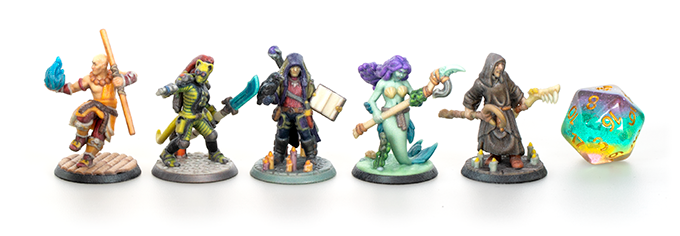 Then baked and self-hardening plastics for modeling were used.
Then baked and self-hardening plastics for modeling were used.
First you need to make a wire frame, so the finished figure will turn out to be more durable, and it will be much easier to keep all the proportions. The wire frame can be attached to the stand, which will make the miniature statue more stable, and it can be easily fixed in any position without fear of smearing small parts with your fingers.
Wire frame for miniature
Gradually, layer by layer, the volume of plastic increases on the frame. Each layer must be baked or dried well, depending on which plastic is used - self-hardening or baked.
Gradually, we begin to add small details and work out the details. In fact, this is a very painstaking process that requires perseverance and some sculpting abilities. For a convenient study of small details, you may need special stacks for modeling, but they can be successfully replaced with improvised tools.
Sculpting tool set
The result is such a miniature statue.
Miniature 28mm baked plastic
By the same principle, large table figures, or some elements of dioramas, can be made.
Sometimes a sculptor is more accustomed to working with plasticine. Then, after sculpting, the stage of preparation and casting of the figurine into a silicone mold is added. This method is suitable for small-scale production of a small desktop army.
But it is necessary to properly prepare the figurine for casting. The finished "warrior", most likely, will have to be divided into several parts, so that it would be more convenient for the caster to remove the molds and make castings. During the cutting process, it is worth adding a few locks so that the finished castings can be easily assembled, like pieces of a puzzle.
Molded figurine against silicone mold
Some craftsmen have learned to cast metal copies. Such soldiers are usually made of low-melting metals (for example, lead) and cast in plaster molds. Sometimes a special silicone is used, but it is a little more difficult to achieve good shedding of a small product in a silicone mold.
Cast metal soldier
In addition to making figurines from scratch, some craftsmen remake ready-made miniatures. This is called conversion.
Conversion in miniatures is a refinement, stylization or alteration of a finished figure. Unfortunately, not every hobbyist has good sculpting skills, and this alteration helps to achieve good results regardless of artistic skills. The main thing is to act very carefully.
Conversion helps enthusiasts achieve amazing figurine detail, add some detail, change the pose, or create a new character that is not yet on sale.
Lord of the Astral Claws turned to Chaos
In addition to making the figures themselves, modelers create colorful locations to immerse themselves in the world of their favorite game. This is true not only for 28mm miniatures, but for example for DND games. Such voluminous locations allow you to immerse yourself in the world of your favorite game much better and make the game more exciting.
Game location for board game Warhammer40k
The creation of such locations is painstaking work, and both improvised and special equipment are used as material.
Role play location
A 3D printer allows you to produce miniature figures and game locations much faster. On the Internet you can find many paid and free models of 28mm figures from different universes or various elements of locations - houses, fences, mechanisms, etc. Adapting or slightly changing the finished 3D model for yourself is much easier than cutting and gluing a finished figure. And creative people with modeling skills are unlikely to have difficulties with the transition to “digital clay”.
Warhammer40k universe 3D miniature model
And of course, dioramas are worth noting. This is a separate art form with a scene or location frozen in time. Dioramas come in different sizes, but each of them impresses with its detail and careful study.
Diorama based on the game STALKER
Each diorama is unique, so the craftsmen use improvised materials to make it. Everything is limited only by the imagination and ingenuity of the artist.
Diorama “Desert Hero”
The main advantage of 3D printing is high detail and repeatability. If you need to make a small batch of miniatures, it will be much easier to print them than to cast, for example. Casting small items is a painstaking process that requires some skill and equipment. It is very difficult to achieve good pourability of small products the first time.
From model to finished figure
And for the manufacture of piece products, such as a diorama element, a 3D printer can replace many materials and tools for modeling. In addition, by using and combining different materials, it is possible to create models that are difficult or almost impossible to create manually. For example, using a special polymer, you can print optically transparent products that can imitate glass.
Which technology to choose
To begin with, it is important to determine the requirements for the printer - will it be used only for the manufacture of 28mm personal army or should it be a universal printing machine? It is important to understand what size the finished model will be, how detailed it should be, and how much time can be spent on post-processing.
Depending on this, it is worth deciding on the technology by which the 3D printer will work. You can choose one of two technologies - FDM or photopolymer printing (there are several technologies, but DLP and LCD printers are currently popular).
FDM
FDM 3D printers use a plastic filament as a material. In a heated extruder, the filament is melted and extruded through a thin nozzle, so layer by layer, a three-dimensional model is grown.
Working principle of FDM 3D printer
Layer thickness and nozzle diameter can be changed in some printer models. The minimum layer is usually 0.1 mm. In some models of 3D printers, a layer of 0.05 is available, but for printing with such a layer, it is important to choose the right many settings and the print speed will be quite slow.
Pros:
-
Large print area
-
Many different materials are available for every “taste and budget”
-
Inexpensive Consumables
Cons:
Of course, FDM printers are hardly suitable for making miniature figures, but they can be successfully used to print large souvenir figures, create game locations and some parts of dioramas.
LCD/DLP
The principles of operation of LCD and DLP printers are very similar. The material used is polymers that harden under the action of UV light. The only difference is that an LCD printer uses an LED matrix in conjunction with an LCD screen as a source of UV radiation, while a DLP uses a projector.
Working principle of photopolymer 3D printer
Pros:
-
The ideal surface of the finished figure
-
Many different materials available
-
High print accuracy even for the smallest items
Cons:
Photopolymer 3D printers are able to create miniature products that cannot be made using FDM technology. This technology will be an ideal choice for creating miniatures, small poster models, etc.
Print examples
Robot printed on Asiga Pro 4k
Figurine made with Phrozen Sonic Mini 4k
28mm 3D printed miniatures
3D Printed Halloween Miniature
3D printed play models
FDM Cube Thrower
Figure making process from 3D model to painting
Best Printer Ranking
FDM
Creality3D Ender 3 (Build Kit)
Features:
Print technology: FDM/FFF
Working area size: 220x220x250 mm
Number of extruders: 1
Max. extruder temperature: max. 255℃
Closed Camera: No
Heated table: Yes
Plastic type: ABS, PLA, PETG, Flex, Decorative plastics, others
A popular and unpretentious 3D printer that many makers liked. Creality3D Ender 3 is sold as a kit (assembly kit), but thanks to the detailed instructions, there should be no problems with assembly.
Wanhao Duplicator 6 Plus
Features:
Print technology: FDM/FFF
Working area size: 200*200*180mm
Number of extruders: 1
Max. extruder temperature: max. 260°C
Closed Camera: Optional
Heated table: Yes
Plastic type: ABS, PLA, PETG, Flex, Decorative plastics, others
Wanhao Duplicator 6 Plus is an updated version of the Duplicator 6. The new modification adds automatic calibration, printing resume after a power outage, and others. You can immediately purchase a printer with a closed case, this will allow you to easily print with composites. Wanhao Duplicator 6 Plus will become a trouble-free workhorse, and thanks to the “omnivorous” extruder, even a beginner will be able to print exotic materials without any problems, such as soft flexes or rubbers.
FlashForge Creator Pro 2
Features:
Print technology: FDM/FFF
Working area size: 200x148x150 mm
Number of extruders: 2
Max. extruder temperature: max. 240°C
Closed Camera: Yes
Heated table: Yes
Plastic type: ABS, PLA, PETG, Flex, Decorative plastics, others
FlashForge Creator Pro 2 is an almost professional dual extruder 3D printer. Thanks to the closed body, Creator Pro 2 has no problems even with composite materials, and two extruders allow the use of soluble support for complex models. Moreover, FlashForge's extruders are independent, which allows you to print 2 mirror or identical models at the same time. This allows you to speed up the production of the same type of models. FlashForge Creator Pro 2 will not only be a good home printer, but also a great helper for a workshop or small production.
LCD
Anycubic Photon Mono 4K
Features:
LCD display resolution: 3840x2400 (4K)
UV wavelength: 405 nm
Working area size: 132x80x165 mm
Layer thickness: 0.01-0.15mm
Inexpensive, but fairly modern 3D printer with a 4K monochrome display. Anycubic Photon Mono 4K will be a good tool for printing miniature models.
Phrozen Sonic Mini 4K
Features:
LCD resolution: 6.1" 4K Mono LCD
XY positioning accuracy: 35 microns
UV wavelength: 405 nm
Working area size: 134x75x130 mm
Layer thickness: 0.01-0.30mm
The Phrozen Sonic Mini 4K is a compact high resolution 3D printer. It allows you to get accurate models even with an abundance of small details. Sonic Mini 4K is a good choice for those who need to print quickly and accurately.
Phrozen Sonic Mighty 4K
Features:
LCD resolution: 9.3" 4K Mono LCD
XY positioning accuracy: 52 microns
UV wavelength: 405 nm
Working area size: 200x125x220 mm
Layer thickness: 0.01-0.3mm
With a larger work area, the Phrozen Sonic Mighty 4K allows you to quickly produce large models or small batches of small items. Such a 3D printer will be a good help for a small workshop or a hobby circle.
Phrozen Sonic Mini 8K
Features:
LCD resolution: 7.1" 8K Mono LCD
XY Positioning Accuracy: 22 µm
UV wavelength: 405 nm
Working area size: 165x72x180 mm
Layer thickness: 0.01-0.3mm
Phrozen Sonic Mini 8K is one of the representatives of 8K photopolymer printers, which can still be counted on the fingers of one hand. The high resolution LCD-matrix allows you to print figures with amazing surface quality and amazing detail. Such a printer is suitable for demanding printers who care about accuracy and the perfect surface of the finished model.
Totals
3D printers are gradually showing themselves to be great helpers in many areas, not only in medicine and industry, but also in home hobbies. Thanks to 3D printing, it is possible to produce small figurines or elements of dioramas much faster, paying more attention to the elaboration of details, rather than painstaking modeling or the search for exotic materials.
And digitalization makes it much easier to share your work and finished models in the community or adjust them to your needs, for example, change the scale or adjust the pose.
Free Shipping
Add to compare
Item added to compare Go
| Manufacturer | Phrozen
Free Shipping
Add to compare
Product added to compare Go
| Manufacturer | Anycubic |
Free Shipping
Add to compare
Product added to compare Go
| Manufacturer | Phrozen
Free Shipping
Add to compare
Product added to compare Go
| Manufacturer | Phrozen
Free Shipping
Add to compare
Product added to compare Go
| Manufacturer | FlashForge |
Add to compare
Product added to compare Go
| Manufacturer | Creality |
Free Shipping
Add to compare
Product added to compare Go
| Manufacturer | Wanhao |
#Application
Share
all materials
Choosing the best 3D printer for printing miniatures
3DPrintStory Reviews Choosing the best 3D printer for printing miniatures
The use of 3D printers for printing game miniatures is gaining more and more popularity today. As the price of 3D printers continues to fall, it is likely that the demand for 3D printed game miniatures will only continue to rise.
If you pick the right 3D printer, you can get amazing 3D models for your board games or to put an inspirational figurine from your favorite game on your desktop.
Today's desktop 3D printers have become reliable, easy to use and deliver decent quality finished products.
How to choose a 3D miniature printer?
There is a wide range of desktop 3D printers that can be used to print miniatures in 3D at home. And if you study the market a bit, or at least the options below, you can get great detailed 3D models.
With the right 3D printer, you can print your own figurines and even create your own board games.
If you don't want to design 3D models of figurines from scratch (and this will really require some skills and time from you), then you can find interesting 3D models on sites with free 3D printable models. After downloading the model, you can immediately print it or edit it before 3D printing for your own needs. We also recommend that you familiarize yourself with interesting 3D models from Dutchmogul. Perhaps in his wonderful collection you will find something interesting for yourself.
To get the same level of detail as the thumbnails above, your 3D printer must meet certain criteria. The most important feature of a 3D printer to consider is the level of detail it can reproduce. This criterion is formed based on the following parameters:
Nozzle diameter
To create a 3D miniature, heated plastic is extruded through a hole. Orifice is the diameter of the nozzle. Make sure the 3D printer nozzle size is less than 0.4mm.
XY Movement Accuracy
The X and Y axis movement accuracy of the 3D printer head should be taken into account. To get a more detailed model, you need to reduce the layer thickness. However, the low thickness means that 3D printing will take longer. In order to print a detailed miniature, you will most likely need a 3D printer that can print with a layer thickness of 100 microns (0.1 mm) or less.
Material type
The most common materials used in 3D printers are ABS or PLA. To get a good surface, after 3D printing, it should be post-processed. If you are using ABS plastic, you can sand the miniature and steam it in acetone to get a smooth surface. It is also worth paying attention to PETG plastics, which are gaining more and more attention and positive user reviews.
Thumbnail size (scale)
If you want to start 3D printing game miniatures, think about the size you would like to get.
A 28mm (~1:58 scale) or 54mm (~1:32 scale) miniature can be made with a standard desktop 3D printer that melts plastic filament. To make a smaller miniature, you will need an SLA Resin printer, which uses liquid resin and strengthens it.
In addition to the figurine, you can also print larger models. 3D printing large models such as houses, huts, castles, trees, and tanks will require more expensive 3D printers that provide faster speeds with good 3D print quality. But there is an important point in the choice. It is better to choose high-quality 3D printing than a large one. You can always separate larger models for printing and then join them together using the same adhesive. The result will be much better than lower quality 3D printing on a 3D printer with a large workspace.
HICTOP CR-10S 3D Printer
Value for money, the Hictop CR-10S is one of the best and most affordable budget 3D printers on the market. The Prusa i3 3D printer was taken as the basis for the design.
The Hictop printer uses quality materials for the power supply, motherboard and motion control systems. The metal framework is a rigid and strong design.
The Hictop printer will arrive unassembled, but assembly is easy. You will have to essentially screw in four bolts and connect the necessary wires. That is, you can proceed directly to 3D printing almost immediately after purchase.
The "S" at the end of the CR-10S stands for two Z-axis lead screws and stepper motors.
Dual axis system improves extruder movement accuracy. As a result, you naturally get more accurate 3D printing overall. This is an excellent inexpensive 3D printer that is suitable for 3D printing miniatures and figurines for board games.
The Hictop 3D printer has a mechanism to control the remaining amount of plastic. If the plastic runs out, the printer will go into pause mode and after feeding new material, you can continue printing from the area where you left off. This is a particularly relevant feature for printing large-scale 3D models.
These 3D printers are quite popular, so you will find a lot of information and tips on how to use them online. In addition, thanks to an active community, the Hictop CR-10S has a large number of modifications and upgrades that you can implement yourself and improve its already decent 3D printing quality.
Hictop CR-10S is a quality and affordable 3D printer, which is definitely suitable for 3D printing miniatures and figures of characters from your favorite games or movies.
FLASHFORGE CREATOR PRO 3D printer
FlashForge 3D Printer Creator Pro took inspiration from Makerbot Replica.
A nice feature of the FlashForge 3D printer is that it includes all custom enhancements from Makerbot. These upgrades include:
- Metal worktable supports. Thus, the working table became more stable during heating and assembling.
- Plastic-coated knobs for easy workbench calibration.
- The Central Processing Unit (CPU) supports Sailfish firmware which allows automatic calibration. In addition, the CPU helps regulate heat and delivers higher quality 3D prints.
The above features make the Creator Pro an excellent miniature 3D printer.
In addition, this 3D printer is made in a closed case, which allows you to print ABS plastic with much less difficulty.
Creator Pro allows you to print two colors at the same time. If you plan to paint the finished model in the future, then you don’t really need this feature, but in general it gives you much more options than the standard analogues with one extruder.
Since the Creator Pro is based on the Makerbot Replica, there is a lot of information available on the internet about this 3D printer.
3D printer SINDOH DP200 3DWOX
If you are looking for a reliable 3D printer for printing miniatures, then you should pay attention to Sindoh DP200 3DWOX. This is the best choice if you want to make 3D mini figures.
This 3D printer is easy to use, suitable even for beginners in the world of 3D printing. Below are some of its features:
- 3D printing table covered with aluminum PTFE.
- 3D printing resolution is 50 microns (0.05 mm).
- Equipped with a high efficiency particulate air filter and a closed chamber for 3D printing, which is especially good when using ABS plastics.
- Easy to use material cartridge chamber.
- Sindoh does an excellent job of printing minifigures in high detail.
One of the disadvantages of the Sindoh DP200 printer is that it can only use manufacturer's filament. Consequently, you will pay more money for cartridges because you will not be able to use materials from other manufacturers. The price of these cartridges, of course, is higher than analogues.
Otherwise, the Sindoh DP200 3DWOX 3D printer is a great option for high quality 3D printing of detailed models.
DREMEL DIGILAB 3D Printer
The use of SLA technology for 3D printing helps to obtain miniature products of very high quality. SLA also helps print miniature parts as small as 28mm. The price of this wonderful 3D printer is comparable to the cost of a laptop.
SLA printing differs from FFF printing in the very essence of the processes. During SLA 3D printing, liquid resin is baked using a UV laser. The formation of the part looks like a gradual lifting of the finished model and a bath with liquid material.
Industry-intensive stereolithographic 3D printers are now available at home! The Dremel Digilab 3D printer has proven itself as a hobby printer, which differs from expensive industrial analogues in its exceptionally smaller workspace.
Key features of the Dremel Digilab 3D printer:
- The minimum wall thickness of the 3D model is 25 microns (0.025mm).
- Faster 3D printing compared to FFF 3D printers.
- Excellent surface quality of the finished 3D model.
Digilab is an excellent SLA 3D printer. It is easy to use and, according to user reviews, reliable.
With this 3D printer, you can use resins to make investment casting molds. It can also be used to make jewelry by casting metals.
Some disadvantages of using SLA for 3D printing:
- It's expensive. The resin needs to be updated, as over time it ages and loses the necessary properties.
- Resins require maintenance. Make sure you start 3D printing only after the balloons created by adding resin to the tank are gone.
Learn more


